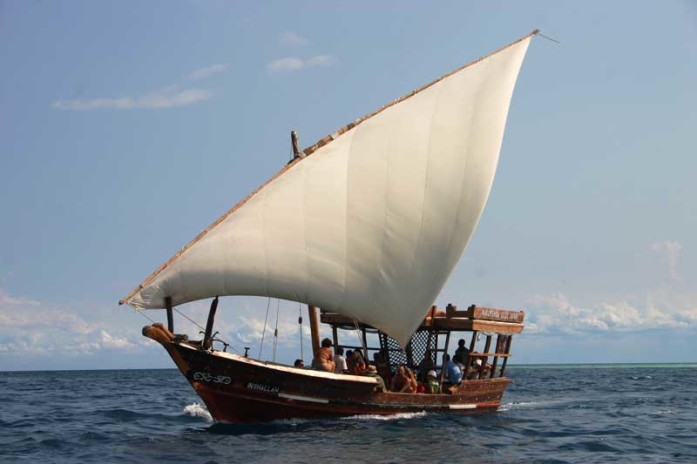Dhow is the generic name of a number of traditional sailing vessels with one or more masts with triangular shaped sails (called more technically “lateen” sails) used in the Red Sea and Indian Ocean region. Historians still don’t know whether the dhow was invented by Arabs or Indians. Typically built with long thin hulls, dhows are trading vessels primarily used to carry heavy items, like fruit, fresh water or merchandise, along the coasts of the Eastern Arabia (Arab states of the Persian Gulf), East Africa, Yemen and some parts of South Asia (Pakistan, India, Bangladesh). Larger dhows have crews of approximately thirty, smaller ones typically around twelve.
It seems that since the Yemeni Hadhrami people, as well as Omanis, for centuries came to Beypore, in Kerala, India for their dhows, the boat must have its origin in India. So, most scholars believe that it originates in India around 600 BC. The Portuguese think that some of the dhow models are inspired from their conqueror caravels.

Dhow making a day tour
[source]
Even today, dhows make commercial journeys between the Persian Gulf and East Africa using sails as their only means of propulsion. Their cargo is mostly dates and fish to East Africa and mangrove timber to the lands in the Persian Gulf. They often sail south with the monsoon in winter or early spring, and back again to Arabia in late spring or early summer.
For celestial navigation, dhow sailors have traditionally used something called kamal. The latter is an observation device that determines latitude by finding the angle of the Pole Star above the horizon, is actually a rectangular wooden card about 2 by 1 inch (5.1 by 2.5 cm), to which a string with several equally spaced knots is attached through a hole in the middle of the card.
The term “dhow” is sometimes also applied to certain smaller lateen-sail rigged boats traditionally used in the Red Sea, the eastern Mediterranean and the Persian Gulf area, as well as in the Indian Ocean from Madagascar to the Bay of Bengal. These include the feluccas used in Egypt, Sudan and Iraq, and the Dhoni used in the Maldives, as well as the “tranki”, “ghrab” and “ghalafah”. All these vessels have common elements with the dhow. On the Swahili Coast, in Kenya, for sample, the Swahili word used for dhow is “jahazi”.
Other types of dhows are: “Baghlah”, “Baqarah”, “Battil”, “Barijah”, “Badan”, “Boum”, “Ghanjah”, “Jahazi”, “Jalibut”, “Pattamar”, “Sambuk”, “Shu’ai”, “Zaruq”.
The article is based on Wikipedia references, only the featured picture is borrowed from another place. The post has educational purposes, this site becoming a reference data base of its own.
If you like what you read, please subscribe to this blog by completing the form. If you want to help more, start by following us on Twitter, and like our page on Facebook. You don’t know what good things may happen. To lighten your day, check our pins on Pinterest, we can be friends there too. Oh, and if you need a really good looking blog attached to your site, or just for fun, to express your feelings more competitively, read this Own Your Website offer! Thank you very much.
